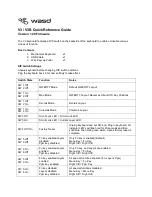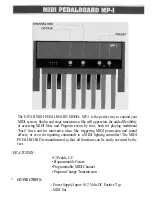
Program Mode
Editing VAST Programs With KVA Oscillators
6-57
Oscillator Specific Control And Modulation Parameters:
Several
KVA
oscillators
also
have
their
own
modulation
parameters
that
must
be
accessed
to
control
the
oscillator’s
intended
function.
Below
is
a
list
of
these
oscillators
and
their
distinctive
parameters,
grouped
by
block
size.
Though
the
following
parameters
could
be
left
at
one
setting,
utilizing
one
of
the
DSPCTL
or
DSPMOD
techniques
described
in
the
above
examples
will
expose
a
wider
range
of
expression
from
each
oscillator.
1 Block:
LPNOIZ
A
noise
generator
combined
with
a
low
pass
filter.
Use
the
Noiz
Frq
parameter
to
control
the
cut
off
frequency
of
the
filter.
NOISE
A
simple
noise
generator.
Use
the
Noise
parameter
to
control
the
noise
initial
amplitude.
SW
+
SHP
(Sawtooth
+
Shaper)
This
oscillator
is
capable
of
basic
FM
Synthesis.
Its
distinctive
parameter
is
Pch
Coar.
This
oscillator
must
come
after
the
sound
source
in
an
algorithm
(either
keymap
or
oscillator)
in
order
to
hear
the
effect
of
Pch
Coar,
which
can
radically
change
whatever
the
oscillator
receives
as
an
input.
Works
well
placed
after
a
Sine
source.
2 Block:
SINE+
This
oscillator
has
an
effect
on
an
input
signal
that
is
similar
to
ring
modulation.
Its
distinctive
parameters
are
Sin+
Pch
and
Sine+
Am.
This
oscillator
must
come
after
the
sound
source
in
an
algorithm
(either
keymap
or
oscillator)
in
order
to
hear
the
intended
effect
of
Sin+
Pch
and
Sine+
Am,
which
can
radically
change
whatever
the
oscillator
receives
as
an
input.
The
Sin+
Pch
and
Sine+
Am
parameters
affect
the
pitch
and
amplitude
of
the
sine
waveform
without
affecting
the
pitch
of
the
input
source,
though
these
parameters
will
have
a
big
effect
on
how
the
input
signal
is
processed.
RES
NOISE
A
noise
generator
combined
with
a
low
pass
filter
with
resonance
control.
Use
the
Noiz
Frq
parameter
to
control
the
cut
off
frequency
of
the
filter.
Use
the
Noiz
Q
parameter
to
control
the
amplitude
of
the
resonance
(a
boost
or
cut
at
the
cut
off
frequency.)
One
technique
for
use
of
this
function
is
to
set
a
high
value
for
Noiz
Q
(so
that
you
hear
a
the
resonance
create
a
tone,)
and
then
on
the
DSPCTL
page
set
C4
as
an
initial
frequency
for
Noiz
Frq,
and
set
Keytrk
to
100ct/key
on
the
Noiz
Frq
sub
page.
Doing
this
causes
the
noise
resonance
frequency
to
match
the
note
of
the
key
played.
SHAPED
SAW
The
Shaped
Saw
oscillator
is
a
sawtooth
oscillator
with
the
ability
to
morph
its
output
shape
between
sawtooth
and
sine
wave
(without
crossfading.)
This
oscillator’s
distinctive
parameter
is
Shape,
which
controls
the
morphing.
With
Shape
set
to
0,
the
oscillator
produces
a
pure
sawtooth
wave.
With
Shape
set
to
127,
the
oscillator
produces
a
pure
sine
wave.
Values
in
between
morph
between
the
two
wave
shapes.
Содержание PC3K6
Страница 24: ...1 6 Introduction Options...
Страница 50: ...4 4 The Operating Modes Using the Modes...
Страница 58: ...5 8 Editing Conventions Special Button Functions...
Страница 130: ...6 72 Program Mode Programming Tips...
Страница 202: ...7 72 Setup Mode Recording A Setup To Song Mode...
Страница 206: ...8 4 Quick Access Mode The QA Editor...
Страница 232: ...9 26 Effects Mono Algorithms...
Страница 268: ...11 18 Master Mode Preview Sample PRVIEW...
Страница 302: ...12 34 Song Mode and the Song Editor Song Editor The EVENT Page...
Страница 328: ...14 14 Keymap and Sample Editing Editing Samples...
Страница 334: ...B 4...
Страница 370: ...D 32 PC3K Objects V 1 31 Effect Chains...
Страница 372: ...E 2 PC3K Legacy File Conversion Object Types and Conversion Details...
















































